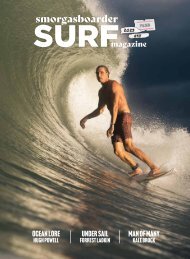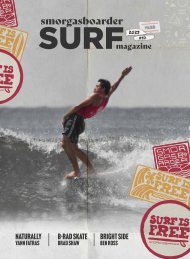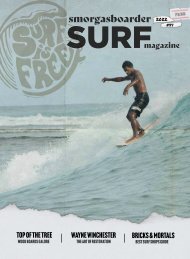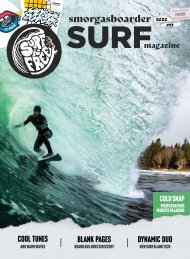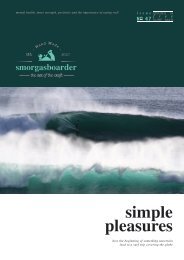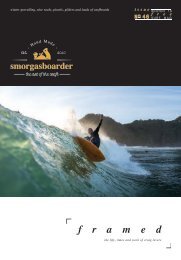SB_issue55_Digital
Create successful ePaper yourself
Turn your PDF publications into a flip-book with our unique Google optimized e-Paper software.
Assumedly, no one in their right mind wants<br />
to surf where everyone else is. Uncrowded<br />
waves, isn’t that what we all dream of?<br />
So, why is it that we all congregate on<br />
top of one another in the same spot?<br />
Partly, it is due to the simple fact that is where<br />
the waves are breaking. It is possibly also due<br />
to the fact that many humans have similar<br />
traits to those of sheep. But what if there was<br />
an alternative where you didn’t have to surf<br />
where everyone else is? Where you didn’t have<br />
to surf where particular waves were breaking<br />
and instead you could surf completely<br />
unridden waves all by yourself away from the<br />
hordes?<br />
Well, dream no more. It is a reality. It is called<br />
foiling. Jack Field talks with us about the true<br />
spirit of foiling.<br />
As Jack passionately explained throughout<br />
our conversation, foiling was never intended<br />
to be something you take to crowded lineups,<br />
potentially slicing through unsuspecting souls<br />
like a giant knife through butter. Its original<br />
invention was to capitalise on wind-generated<br />
swell that, until now, remained unridden due<br />
to the fact that missing from the essential<br />
ingredient in the mix to create surfable<br />
waves was a complementary sea floor. If the<br />
wave doesn’t break, you can’t ride it with a<br />
surfboard, but you can with a foilboard.<br />
First things first, for those who might have<br />
missed edition 51, what is a foil, or specifically,<br />
foiling? As we firmly tongue-in-cheek<br />
described it, foiling is where you attach what<br />
resembles a huge butcher’s cleaver with<br />
wings to a platform resembling a surfboard.<br />
Technically it is about engaging hydrofoil<br />
technology.<br />
A hydrofoil is a lifting surface that operates<br />
in water, and are similar in appearance and<br />
purpose to aerofoils used by aeroplanes. The<br />
hydrofoil has a flat or curved winglike surface<br />
that is designed to lift the board by means of<br />
the reaction upon its surface from the water<br />
through which it moves. A hydrofoil works<br />
on the principle of Newton’s third law — “For<br />
every action in nature, there is an equal and<br />
opposite reaction.” As the surfboard begins to<br />
gain speed, the wings push the water down,<br />
creating an upward force lifting the board out<br />
of the water and, as the board gathers speed,<br />
there is less friction, creating less drag and<br />
assisting with an acceleration of speed.<br />
So basically, once you have the speed to<br />
engage the foil and lift the board out of the<br />
water, you have the kind of acceleration you<br />
cannot achieve on a normal surfboard without<br />
riding a breaking wave. If the wave doesn’t<br />
break, a traditional surfboard will drop back<br />
off the face of the wave because the wave<br />
is moving faster than the surfboard, but with<br />
a hydrofoil you are engaging the energy in<br />
the water below the wave, rather than on the<br />
surface, to generate speed and hence you can<br />
more easily maintain your momentum on the<br />
wave.<br />
In short, you can catch unbroken waves with<br />
a foil that you cannot on a normal surfboard,<br />
thus opening Pandora’s box and unridden<br />
swell galore right along the Australian coast.<br />
Jack elaborates on the potential breaks all<br />
within our grasp.<br />
“Look out the window on nearly any given day<br />
and what you see is wind. The resulting effect<br />
of wind travelling across a body of water is<br />
that it generates swell, whether that be in the<br />
ocean or on a river or a lake.<br />
“Well, my focus for many years has been on<br />
getting in sync and harnessing this energy,<br />
the energy that is transferred from wind to<br />
water. From my own esoteric point of view,<br />
I find it calming – to endeavour to be in sync<br />
with nature and ride that energy. What we<br />
have to do as surfers however, is wait until all<br />
that energy hits something (an elevated ocean<br />
floor) and throws it up in the air, whether it’s<br />
30 to 40 foot waves at the Eddie (Eddie Aikau<br />
Memorial Big Wave Contest in Hawaii) or a<br />
two foot swell here in Mooloolaba. We all<br />
congregate around that transition from swell<br />
into waves.<br />
“Some of us get carried away with the fact<br />
that ‘it’s mine’ and we will snake and carry on<br />
and get all worked up about our ‘ownership’<br />
of those said waves, when in actual fact, if you<br />
look around at the some 3000km of eastern<br />
seaboard, there are thousands of rideable<br />
swells that are coming into beaches, or not<br />
even to beaches, it can be just the shoreline<br />
that is unridden and totally there. We simply<br />
don’t go there because it’s not breaking.<br />
But there is a way we can capitalise on wind<br />
generated swell, and that is through foiling.<br />
And to be able to ride a wind generated swell<br />
with no one around, it gives you such a sense<br />
of serenity through feeling the connection to<br />
the energy source. It is hard to describe. Ask<br />
anyone who has foiled downwind offshore.”<br />
81 / #55 / <strong>SB</strong>




